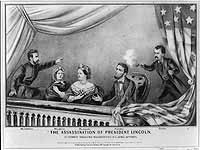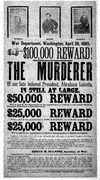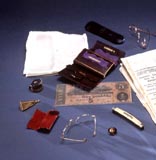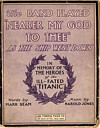Today in History: April 14
[D]ying as he did die, by the red hand of violence, killed, assassinated, taken off without warning, not because of personal hate…but because of his fidelity to union and liberty, he is doubly dear to us, and his memory will be precious forever.Oration by Frederick Douglass, delivered at the unveiling of the Lincoln monument, Lincoln Park, Washington, D.C., April 14, 1876.
African-American Perspectives, 1818-1907

The Assassination of President Lincoln, Ford's Theatre, Washington, D.C.,
lithograph, Currier & Ives, 1865.
Portraits of the Presidents and First Ladies, 1789-Present
Shortly after 10 P.M. on April 14, 1865, actor John Wilkes Booth entered the presidential box at Ford's Theatre in Washington, D.C. and fatally shot President Abraham Lincoln. As Lincoln slumped forward in his seat, Booth leapt onto the stage and escaped out the back door. The paralyzed president was immediately examined by a doctor in the audience and then carried across the street to Petersen's Boarding House where he died early the next morning.
Lincoln's assassination was the first presidential assassination in U.S. history. Booth carried out the attack thinking it would aid the South which had just surrendered to Federal forces. The suspicion that Booth had acted as part of a conspiracy of Southern sympathizers increased Northern rancor. Whether Lincoln would have been able to temper the Reconstruction policies enacted by the Radical Republicans in Congress is left to historical speculation because of his untimely death as the United States transitioned from civil war to reunification and peace.

Wanted Poster, issued by the War Department, Washington, D.C., April 20, 1865.
American Time Capsule: Three Centuries of Broadsides
Within days of the assassination, the War Department issued wanted posters for the arrest of Booth and his accomplices John Surratt and David Herold. Booth and Herold eluded capture until April 26, when federal troops discovered them hiding in a tobacco barn near Bowling Green, Virginia. Herold surrendered, but Booth stayed under cover and was shot as the barn burned to the ground. He died later that day.
Booth's co-conspirators Lewis Paine—who had attempted to murder Secretary of State William Henry Seward—George Atzerodt, David Herold, and Mary Surratt, were all executed for their part in the assassination conspiracy. Several other conspirators were sentenced to imprisonment.
The death of President Lincoln resulted in an outpouring of grief nationwide. After lying in state at both the White House and the Capitol, Lincoln's body was transported to the railway station where it began a 1,700-mile journey back to the president's native Springfield, Illinois. The nine-car funeral train stopped at cities along the way so citizens could pay their respects to the fallen leader. On May 4, Lincoln was finally laid to rest.
Many monuments raised to Lincoln over the years, across the nation and around the world. On April 14, 1876, a monument to Abraham Lincoln was unveiled in Washington, D.C.'s Lincoln Park. Read the Oration by Frederick Douglass, Delivered on the Occasion of the Unveiling of the Freedmen's Monument in Memory of Abraham Lincoln. Better known to the nation is another memorial to Lincoln, also located in Washington, D.C. Designed by the sculptor Daniel Chester French, the Lincoln Memorial stands at the foot of the nation's Mall and was dedicated on May 30, 1922.

Contents of Abraham Lincoln's Pockets, and Newspaper Recounting the Assassination, April 14, 1865.
American Treasures of the Library of Congress
- To learn more about the assassination of Abraham Lincoln, visit Mr. Lincoln's Virtual Library which includes a time line of the events and a gallery of related images. This collection also contains a digital presentation on the Emancipation Proclamation and a list of Lincoln Resources available in American Memory and the Library's online exhibition American Treasures.
- Words and Deeds in American History also features several Lincoln artifacts, from his student sum book to a letter about an early courtship. For more documents related to the sixteenth president, search this collection on Lincoln.
- Some believed Booth was not the man captured that day in Virginia. In American Life Histories, 1936-1940 a "Mrs. J.D. Rylee" tells of an educated gentleman who stayed with her family when she was a child. She is certain it was John Wilkes Booth. See also the interview with Virginian "Robert Carter" — he too believed Booth escaped capture.
- Don't miss the Today in History features on the Emancipation Proclamation, the Gettysburg Address, and Lincoln's First Inauguration.
- Search on the term Lincoln Memorial in The Capitol and The Bay: Narratives of Washington and the Chesapeake Bay Region, ca. 1600-1925 to find The Development of Washington with Special Reference to the Lincoln Memorial. This address, delivered in 1910 by Glenn Brown, Secretary American Institute of Architects, to Washington Chamber of Commerce discusses location of what was to become the Lincoln Memorial located on the national Mall.
- Visit the Ford's Theatre National Historic Site, maintained by the National Park Service, to learn more about the fateful event that occurred there.
R.M.S. Titanic

"The Band Played 'Nearer My God to Thee' as the Ship Went Down,"
Harold Jones, composer, 1912.
Historic American Sheet Music, 1850-1920
Also on this day, April 14, in 1912, the R.M.S. Titanic struck an iceberg off the coast of Newfoundland and sank to the bottom of the sea, taking the lives of over 1,500 people.
The Titanic was on its maiden voyage from Southampton to New York when the tragedy occurred. A later investigation showed that the ship had failed to follow all safety procedures. Besides traveling through dangerous waters at high speed (after receiving repeated warnings concerning the presence of icebergs), the Titanic also had aboard an insufficient number of lifeboats for the passengers and crew.
- To see contemporary coverage of the disaster, visit the Maryland Newspaper Project's exhibition Images of the Titanic From Maryland Newspapers.
- To see various views of the statue erected in Washington, D.C.'s East Potomac Park to the memory of the victims of the Titanic, search on the term Titanic in the collections Washington As It Was, 1923-1959 and FSA/OWI Photographs, 1935-1945, (the Black-and-White Photographs).
- Search on the keyword voyage in A Maritime Perspective on American Expansion, 1820-1890 to see items from the Library at Mystic Seaport which illustrate major themes in the history of maritime westward expansion. See, for example, a watercolor painting of the ship Great Republic which foundered in 1872, and a plan of the bark Bowhead which was lost in 1884. (This collection was digitized in conjunction with the Library of Congress and Ameritech.)